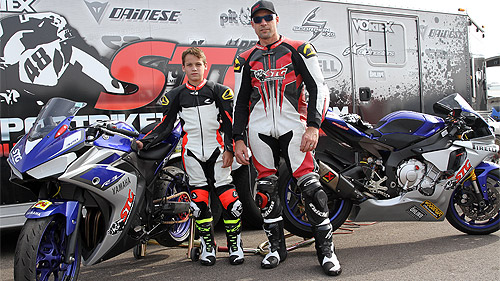Find your parts fast
choose your make, Model & Year
-
Riding a motorcycle is one of the greatest pleasures life has to offer for sure. It doesn't matter what you ride or where you ride it, motorcycles make the world a better place. If you own a sportbike there is no better place to ride it than on a race track. Modern sportbikes like the Yamaha R6, Suzuki GSXR 1000, BMW S1000RR and Kawasaki ZX 10R are fun to ride on the street, but the reality is you are not able to explore their true potential on the street. The race track is the best place to safely explore your bikes limits and improve your riding skills.
Motorcycle Track Days are held all over the country and make getting on track super easy to do. There are Track Day Organizations all over the country promoting safe, structured track days with vary levels of instruction available to help you make the most of your time on track. Here at STG we ride with Sportbike Track Time when we hit the track. Before you take your bike to the track it needs to be prepped to pass tech inspection. In this How To Guide we will cover the most common requirements to help you prep your bike. Each organization has their own set of requirements, this guide is intended to give you a baseline to get started.
-


How To Prep Your Motorcycle for a Track Day
-
So you just got a new bike on Thursday and you are heading to the track Friday... In this video we show you what it takes to get a brand new bike prepped and ready to pass Tech Inspection for the advanced group with Sportbike Track Time. While every organization has their own specific set of regulations the items we cover in this video should be enough to pass most of them without issue. (Make sure you review the regulations for the organization you will be riding with before you go!)
Most organizations divide the riders into groups based on their skill level. Each of these groups typically have their own set of tech inspection regulations for bike prep. In this video we are prepping Van's new Suzuki GSXR 1000R for the advanced group which requires a higher level of bike prep than the novice group does with STT. In order to get the new GSXR on the track we will be changing the coolant to an approved product and safety wiring multiple items on top of the more basic items like taping the lights. We have follow up videos breaking down the coolant change, safety wire process and a few others key items listed below this one if you would like a deeper dive to help you get ready.
-
How To Change Your Motorcycle Engine Coolant
-
-
The engine coolant your motorcycle comes with from the factory protects your cooling system from freezing and lubricates the system. Ethyl glycol based engine coolant is very slick and difficult to clean up if there is a spill on the race track (it is easier to clean oil spills). For your safety as well as that of the other riders on track most organizations will require some of all of the riding groups to replace the ethyl glycol based coolant with a non-ethyl based coolant or water in order to pass tech inspection. If a coolant change is a requirement of your track day organization we recommend getting this done before you head to the track.
For coolant changes we use Engine Ice Hi-Performance Coolant in all of our STG bikes and recommend this product. It is biodegradable, typically improves the efficiency of the cooling system and cleans up easy if there is a spill. In this video Van shows you what it takes to change the coolant on the 2018 Suzuki GSXR 1000R. While every bike is a little different the process we show here will work perfectly on most bikes. The key is bleeding the system to get the air out before you run the bike which we cover in depth here.
How To Safety Wire Your Motorcycle Oil Filter, Drain Plug and Fill Cap
-
Safety Wiring your Oil Drain Plug, Oil Filter and Oil Fill Cap is a tech requirement in most of the advanced track day riding groups. End of the day we feel this is worth doing for both street and track riding because it is an inexpensive way to avoid very expensive problems. There is more than one way to get through a safety wire project, in this video we show you how to do it without purchasing pre-drilled plugs or filters. Replacing your oil drain plug, oil filter and oil fill cap with pre-drilled parts saves a lot of time and effort. With that said that is the most common approach we see riders use to safety wire their bikes.
-
The Right Way To Remove Your Track Bikes Kickstand
-
-
There is a whole lot more to removing your kickstand than running out a couple of bolts. Pretty much every sportbike has a switch on the kickstand that is in the closed position when the stand is up (circuit completed) and in the open position when it is down (circuit is open). When you remove the kickstand you need to permanently jump the kickstand switch wires together. It is important to understand that anytime the connection opens up the motor will cut out just like hitting the kill switch. If this happens at the wrong time it can cause a crash. We have seen riders crash due to a failed kickstand switch rewire more than once.
If and when you decide to remove your kickstand we strongly suggest you solder the kickstand switch wires together and seal them with shrink tubing after. This may take a couple extra minutes as compared to a simple crimp connector, but it will not fail as long as you do a clean job.
